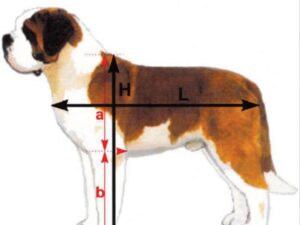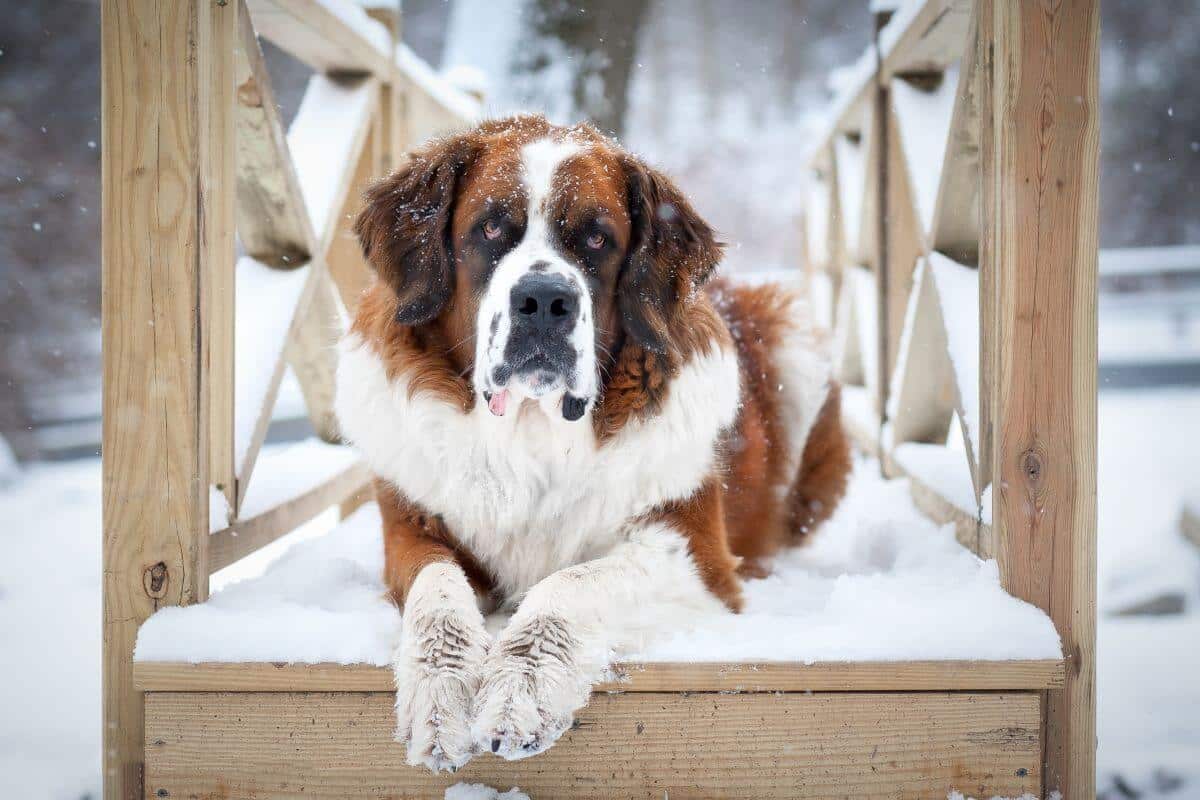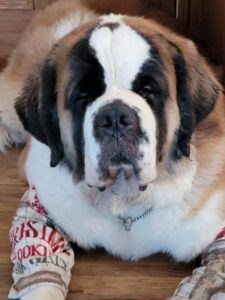
The Importance of the Proportionately Tall Saint Bernard
Discover the importance of the proportionately tall Saint Bernard breed. Learn about its historical tasks and the traits that matter most.

Home » Dog Breeds » Saint Bernard Dog Breed


The Saint Bernard is a breed of immense strength and size, a gentle giant renowned for its rescuing instincts and a rich history as an invaluable companion in Alpine rescue missions. Esteemed for their kind demeanor and a patient approach to life, Saint Bernards have transitioned from diligent workers to affectionate members of the family, all the while retaining a noble bearing that reflects their storied past.
Working
26 – 30 inches
120 – 180 pounds
8 – 10 years
| Country of Origin | Switzerland |
|---|---|
| Bred For | Search and Rescue |
| Known For | Gentle Nature, Size, Intelligence |
| Popularity | Moderate |
| Temperament | Playful, Charming, Inquisitive |
| Activities | Search and Rescue, Running, Conformation Shows, Dog Sports, Mental Stimulation |
The Saint Bernard is a breed steeped in rich history and tradition, originating in the Swiss Alps and the Italian-Swiss border region. These majestic canines are named after the Hospice Saint Bernard, a traveler’s refuge that was founded by St. Bernard of Menthon in the 11th century. The monks of this hospice initially bred these dogs for companionship and as working dogs, but they soon discovered the breed’s innate ability for mountain rescue.
Saint Bernard’s reputation as a rescue dog was solidified over centuries as they were credited with saving the lives of many travelers caught in treacherous alpine conditions. Their incredible sense of direction and resistance to cold made them indispensable to the monks. It’s said that a Saint Bernard named Barry became legendary for his heroic rescues, saving over 40 lives during his lifetime.
Official recognition of the breed has been bestowed by various kennel clubs around the world. The American Kennel Club (AKC), the Fédération Cynologique Internationale (FCI), and The Kennel Club (UK) all recognize the Saint Bernard as a distinct breed, with the AKC formally doing so in the late 19th century. The breed standards set forth by these organizations ensure that Saint Bernard’s noble and distinct characteristics are preserved.
The breed’s purpose has evolved over the years. While their role in mountain rescue may have diminished, they have found new purpose in the show ring, as family companions, and as participants in dog sports. Saint Bernard’s benevolent nature has also made them popular as therapy dogs, providing comfort to those in need with their serene presence.
The breed’s journey from alpine rescuer to beloved pet and show dog is a testament to their versatility, temperament, and the enduring bond between dogs and humans. These gentle giants, with their storied past and versatile abilities, continue to be an emblem of loyalty and bravery.
In terms of stature, male Saint Bernards are imposing figures, standing at an average height of 28 to 30 inches at the shoulder. Females are slightly more petite, typically ranging from 26 to 28 inches.
It is the breed’s considerable mass that complements their height, with males weighing between 140 to 180 pounds, while females generally tip the scales at a slightly lesser range of 120 to 140 pounds.
The Saint Bernard is a paragon of balance and proportion, with a body that is slightly longer than it is tall, giving them a robust and muscular look without compromising agility. Their substance is matched by bone strength appropriate to their size, ensuring they are neither cumbersome nor delicate. This harmonious blend of size and strength equips them well for their traditional roles that demand both power and endurance.
Texture: Saint Bernard’s coat comes in two distinct varieties: smooth and rough. The smooth coat is dense and lies flat, providing ample warmth and resistance to the elements. In contrast, the rough coat is longer and displays a slight wave, offering a more pronounced protection against harsh weather. Both types possess a thick and durable underlay that ensures the breed is well-insulated.
| Standard Color | |
|---|---|
| Brown & White | ee |
| Mahogany & White | ee |
| Orange & White | ee |
| Red & White | ee |
| Brindle & White | ee |
| Rust & White | ee |
| White & Brown | ee |
| White & Orange | ee |
| White & Red | ee |
| Standard Marking | |
|---|---|
| Black Mask | ee |
The Saint Bernard sports a long tail that is carried low when at rest, extending the line of the back. In action, the tail may be elevated and is often seen with a slight curve, but it does not curl over the back. It serves as a rudder of sorts when the breed is in motion, aiding in balance. Historically, the tail has been an important tool for these dogs in their rescue work, helping them to maintain stability in treacherous conditions. While some working breeds have a history of tail docking, Saint Bernard’s tail is typically left in its natural state, undocked, allowing the dog to express its emotions and intentions clearly through its carriage and movement.
The Saint Bernard is a compassionate and gentle giant, renowned for its role as a steadfast companion and rescuer. Those looking to welcome a Saint Bernard into their lives must recognize the commitment required to nurture such a sizable and devoted breed. Prospective handlers should consider the breed’s space requirements, grooming needs, and the importance of early socialization and training to ensure the development of well-mannered behavior.
Saint Bernards are generally robust dogs, bred for hard work in challenging environments. Nonetheless, they can be susceptible to certain breed-specific health issues that potential caretakers should be aware of. It’s crucial to maintain an ongoing relationship with a trusted veterinarian who can provide regular health screenings and timely interventions.
Saint Bernard typically enjoys a lifespan of 8 to 10 years, but with proper care, regular check-ups, and a balanced diet, many can live beyond these years.
Saint Bernard, like any breed and mixed breed, may be inclined to certain hereditary health conditions. Potential owners should be vigilant for:
Regular veterinary check-ups are imperative for early detection and management of these conditions. A veterinarian can provide guidance on preventive care, which may include diet, exercise, and, in some cases, early surgical intervention to enhance the quality and length of the dog’s life.
Saint Bernards are cherished for their gentle, friendly, and loving nature, particularly towards their family. Despite their considerable size, these dogs are known for their patience and are typically cautious around children, making them excellent family companions. Their loyalty and protective instincts are commendable, yet they are not overly aggressive, balancing their strong presence with a calm demeanor.
Their intelligence is paired with a tendency towards stubbornness, necessitating consistent and patient training from an early age to manage their independent streak. The breed’s social nature means they thrive on interaction and affection, often seeking to be involved in family activities.
Saint Bernards are known to be adaptable to different living environments, but due to their large size, they need ample space to move and regular exercise to maintain their health. Their patience and tolerance make them particularly suitable for families with children, as they can handle the energy and unpredictability of kids well. These dogs exhibit a calm and easygoing temperament, often mirroring the energy levels of their household, which makes them active when encouraged but also content to relax with their owners.
In general, Saint Bernards get along well with other dogs, often doing well with much smaller pets as well, such as cats. They are not typically aggressive or territorial, and their good relationships with other animals are largely due to their mellow and kind nature. However, like any breed, they can exhibit more assertive behavior in certain situations, especially if not properly socialized. Socialization from a young age is critical to ensure they are well-behaved and do not develop tendencies to assert dominance, particularly for male Saint Bernards.
While they are naturally tolerant, calm, and well-behaved, Saint Bernards will protect their owners if they perceive a real threat. Training and proper socialization are essential to prevent any misinterpretation of situations that could lead to aggressive responses. The key to a well-mannered Saint Bernard is ensuring they spend time with other dogs during their formative puppy years, fostering their inherently sociable and friendly nature.
When considering the feeding and nutrition of a Saint Bernard, it’s important to recognize that their dietary requirements will change as they grow from puppies to adults, and later into their senior years. Saint Bernard puppies, during their rapid growth phase, require about 1 ½ to 7 ½ cups of dry dog food daily, depending on their age and size. Adult Saint Bernards typically need about 6 ½ to 8 cups, and seniors slightly less, around 6 to 6 ½ cups of kibble each day.
The dietary needs of each Saint Bernard can be quite individualized, influenced by their health status, lifestyle, weight, and metabolism. This makes it crucial for owners to collaborate with a veterinarian to determine the optimal feeding regimen for their specific dog. During the early stages, it is also essential to manage the amount of protein a Saint Bernard puppy consumes, avoiding high levels (more than 25%) that can lead to an imbalance affecting their growth. Instead, they should receive puppy food rich in DHA for proper brain and eye development.
Owners must be mindful not to overfeed their Saint Bernard puppies, as excessive food does not translate to fat but can instead lead to growth at a rate that their skeleton cannot support. Regular check-ins with a veterinarian will help ensure that your Saint Bernard is on the right track nutritionally, supporting their overall well-being throughout each stage of life.
Training a Saint Bernard requires patience and consistency due to their intelligent but sometimes stubborn nature. These dogs are capable of learning a wide variety of commands and tasks, and they generally have a gentle demeanor. They are not particularly known for excessive barking, but like any dog, they may vocalize to alert their family of something out of the ordinary or if they are bored or anxious.
Saint Bernards are intelligent, which can aid in training, but they also have an independent streak that may require a firm yet gentle hand in training. Their intelligence means they can learn quickly, but their size and strength necessitate proper training to ensure they can be managed safely.
Their potential for wanderlust is moderate; they may be inclined to explore if given the chance, but they are also quite content to stay at home with their family. Predatory tendencies are not high on the list of breed characteristics, as Saint Bernards were bred for rescue and companionship, not for hunting.
Saint Bernards require regular exercise to maintain their robust health and to keep their minds stimulated. Despite their grand size, they have moderate exercise needs that should be met with thoughtful activities suitable for their build. A routine that includes leisurely walks, allowing them to explore and enjoy the surroundings at a comfortable pace, is ideal. These gentle giants also relish playtime that aligns with their sociable nature, such as interactive games that foster bonding with their human companions.
| Energy Level | Moderate |
|---|---|
| Exercise Requirements | 30 Minutes/Day (Minimum), Daily Walks, Vigorous Running, Regular Exercise, Playing with Another Dog, Mental Stimulation |
It’s crucial to balance the intensity of their activities, ensuring they are engaged without becoming overexerted. Play sessions should be interspersed with rest, particularly important for a breed that can be prone to overheating and exhaustion. Their playfulness, while not as high-spirited as smaller breeds, is expressed through their love for gentle games and companionship.
A well-exercised Saint Bernard is a content and well-behaved dog. Structured physical activities can help mitigate potential behavioral issues stemming from boredom. Providing a Saint Bernard with consistent, suitable exercise will result in a harmonious household and a truly happy dog.
Grooming a Saint Bernard is a task that calls for a committed handler. These gentle giants have a dense and water-resistant double coat that requires regular attention. The thick undercoat is shed biannually and during this time, daily brushing becomes essential to manage the loose fur. Outside of the shedding season, grooming a few times a week is typically sufficient to keep their coat in good condition.
| Coat Type | Dense, Short, Smooth |
|---|---|
| Grooming Requirements | Weekly Brushing, Occasional Bathing, Routine Ear Cleaning, Periodic Nail Trimming, Regular Tooth Brushing |
Due to their size and the abundance of their coat, the grooming sessions provide an excellent opportunity for human companions to check for any skin issues, such as hot spots or parasites, which can hide beneath the thick fur. Regular ear checks are also crucial to prevent infections, considering their ears can trap moisture and debris.
Bathing a Saint Bernard doesn’t need to be a frequent activity; every few months is generally adequate unless they find themselves exceptionally dirty. It’s crucial to thoroughly dry their coat after each bath to prevent any cold or skin problems.
Caring for their nails is another aspect of grooming that should not be overlooked. These should be trimmed regularly to ensure comfort in their paws, particularly since their heavy build can put more pressure on their feet. A partner in grooming can find this task easier with a Saint Bernard, ensuring the dog’s ease and safety during the nail clipping.
When considering a Saint Bernard as a companion, prospective caretakers should be mindful of their sizable stature and the environment in which they will thrive. Despite their considerable bulk, Saint Bernards can adapt to apartment living if their space needs and exercise requirements are met diligently. They are typically placid indoors but will need ample space to rest comfortably without feeling cramped.
Saint Bernards are well-equipped for cold climates, thanks to their dense, insulating coat, which offers them protection against frigid temperatures. In fact, they often display a notable fondness for snow and colder weather, harking back to their heritage as Alpine rescuers. Conversely, their thick fur makes them more susceptible to overheating, so handlers should provide a cool, shaded retreat during warmer months, and exercise should be limited to cooler parts of the day.
As for hotter climates, extra caution is necessary. Ensuring that a Saint Bernard has access to air conditioning and plenty of fresh water is vital to prevent heatstroke. Their exercise regime in such weather should include regular breaks and might even necessitate a shallow pool or a sprinkler to help them keep cool.
Welcoming a Saint Bernard puppy into your life is an adventure filled with both joy and responsibility. These affectionate, oversized bundles of fur grow rapidly, and their development during the puppy stage is critical to their future health and temperament. Ensuring they receive proper nutrition, socialization, and training from the outset will lay the groundwork for a well-adjusted adult dog.
Caring for Saint Bernard puppies demands a thoughtful approach from their human companions. Early socialization is key; exposing them to a variety of people, sights, sounds, and experiences helps to ensure that they grow into sociable and well-mannered adults. Gentle handling and positive reinforcement will foster a trusting bond between the puppy and their caretaker.
Nutrition is paramount in this early stage. Puppyhood is when a Saint Bernard experiences the most significant growth, so a diet formulated for large-breed puppies is essential to support their rapid development and to help prevent bone and joint issues as they age. Consultation with a veterinarian can provide a feeding plan tailored to the puppy’s individual needs.
Training should begin early, focusing on basic commands and house manners. Saint Bernards are eager to please and respond well to patient, consistent training sessions. Due to their size and strength, it’s important to instill good leash behavior early on to ensure that they can be managed safely when fully grown.
In terms of health, scheduling regular veterinary check-ups is crucial to monitor their growth and to keep up with vaccinations and parasite control. These early visits to the vet are also the opportune time to discuss spaying or neutering and to identify any potential health concerns specific to the breed.
Saint Bernard dogs, renowned for their strength and gentle nature, can participate in a variety of activities and dog sports that capitalize on their physical attributes and temperament. It is important for handlers to engage these dogs in activities that not only stimulate their minds but also provide an outlet for their energy. Here are some activities and dog sports in which Saint Bernards can excel:
Participation in these activities requires consistent training and socialization, as well as a consideration of the physical demands on the breed. Engaging a Saint Bernard in these sports not only promotes physical health but also strengthens the bond between dog and handler, offering both mental stimulation and mutual enjoyment.
The Saint Bernard is recognized by the world’s leading registries and kennel organizations, which categorize the breed into a specific Group based on its unique characteristics. This breed is recognized worldwide under the following Group designations:
| Organization | Group Designation |
|---|---|
| AKC (American Kennel Club) | Working |
| UKC (United Kennel Club) | Guardian |
| CKC (Canadian Kennel Club) | Working |
| ANKC (Australian National Kennel Council) | Not Recognized |
| RKC (The Royal Kennel Club) | Working |
| FCI (Fédération Cynologique Internationale) | Group 2: Pinscher and Schnauzer Molossoid Breeds – Swiss Mountain and Cattle Dogs; Section 2.2: Molossian Type, Mountain Type |
The ideal Saint Bernard is described by a Breed Standard that is approved by each of the world’s leading registries and kennel organizations. The Breed Standards for this breed may be found in the following links:
| Organization | Breed Standard |
|---|---|
| American Kennel Club | AKC Saint Bernard Breed Standard |
| United Kennel Club | UKC Saint Bernard Breed Standard |
| Canadian Kennel Club | CKC Saint Bernard Breed Standard |
| Australian National Kennel Council | Not Recognized |
| The Royal Kennel Club | RKC Saint Bernard Breed Standard |
| Fédération Cynologique Internationale | FCI Saint Bernard Breed Standard |
The Saint Bernard is a breed cherished by many, with clubs worldwide dedicated to their preservation and appreciation.
In the United States, the Saint Bernard Club of America was incorporated in 1888 with a mission to protect and promote the breed. It serves as a hub for education, providing resources for current and potential owners and breeders, as well as judges at dog shows. The club organizes events, offers a breeder referral system, and supports rescue efforts, all aimed at fostering a community around this noble breed.
Canada has the Saint Bernard Fanciers of Canada which was accredited by the Canadian Kennel Club in 2010. Their goals include the protection of the breed, promoting selective breeding in accordance with the CKC breed standard, and the organization of specialty shows. They advocate for the breed’s welfare through continuing education and host their National Specialty conformation show to celebrate and evaluate the breed against these standards.
In the United Kingdom, The English St. Bernard Club boasts a long history, having been registered with the Kennel Club in 1922, although records suggest its founding dates back to 1891. The club owns historic silver trophies from the late 1800s, indicating a longstanding tradition of excellence and celebration of the breed. They organize a variety of events, including championship shows, educational seminars, and the St Bernard of the Year competition, providing opportunities for members to engage and share their passion for Saint Bernards.
These clubs are testament to the enduring legacy of the Saint Bernard, uniting enthusiasts and breeders in their dedication to the health, well-being, and legacy of this distinguished breed.
Despite their size and loving nature, Saint Bernards can find themselves in need of new homes due to various circumstances. Rescue organizations are pivotal in providing these gentle giants with the care and compassion they need during such transitions.
In the United States, the Saint Bernard Rescue Group is dedicated to improving the lives of Saint Bernards that require permanent homes. Established in 2010, they have a broad network of volunteers across North America working towards public education about the breed, reducing overbreeding, and combating inhumane treatment. Based in Westminster, MD, the rescue group operates with the support of donations and aims for the permanent placement of Saint Bernards into loving homes.
The United Kingdom is home to the St. Bernard Trust, the original and longest-established non-profit charity for the breed in the country. Established in 1975, they gained charitable status in 1988 and are entirely financed through voluntary donations. Their mission is to rescue and rehome previously unwanted, often neglected, and abandoned Saint Bernards.
The iconic image of a Saint Bernard with a barrel is a myth popularized by entertainment and folklore. Historically, these rescue dogs did not carry barrels around their necks. The myth suggests that the barrels contained brandy to warm victims trapped in the snow, but this is not based on fact.
Saint Bernards have a life expectancy of around 8 to 10 years. Due to their large size, they are considered to have a shorter lifespan compared to smaller breeds. Providing a healthy diet, regular exercise, and proper veterinary care can contribute to their longevity.
Saint Bernards are one of the largest dog breeds, with males typically weighing between 140 to 180 pounds and females between 120 to 140 pounds. They can stand about 26 to 30 inches tall at the shoulder. Their large size is one of their most distinctive features.
Saint Bernards do shed, especially seasonally. They have a dense double coat that requires regular grooming. During shedding season, they can shed a considerable amount of hair, so regular brushing is recommended to manage their shedding.
Saint Bernards are not typically aggressive; they are known for their gentle temperament. However, like any breed, they can become aggressive due to poor training, lack of socialization, or mistreatment. It’s essential to provide proper training and socialization from a young age.
Saint Bernards are excellent family dogs known for their gentle nature and patience with children. They tend to be affectionate and devoted to their families, making them great companions. However, due to their size, interactions with small children should be supervised.
Saint Bernards can be protective of their families due to their loyal nature. They are not typically aggressive but may stand between their owner and a perceived threat. Their size alone can be a deterrent to intruders.
While Saint Bernards are protective, they are not the ideal choice for a guard dog due to their friendly demeanor. They may alert their family to strangers but are more likely to greet an intruder with a wagging tail rather than a bark or growl.
Saint Bernards are not hypoallergenic. They shed and produce dander, which can trigger allergic reactions in sensitive individuals. Families with allergies should consider this before bringing a Saint Bernard into their home.
Saint Bernards are not inherently lazy, but they do have a moderate energy level. They enjoy being active but also appreciate relaxation time. It’s important to provide them with daily exercise to keep them healthy and prevent boredom.
Saint Bernards are known to drool, especially after drinking water or when they are excited. Their drooling is due to the shape of their mouths and lips. Keeping a towel handy for clean-ups is a common practice for Saint Bernard owners.
Saint Bernards can be good with cats, especially if they are raised with them from a young age. They tend to have a calm and friendly nature, but individual temperaments can vary. Proper introductions and socialization are key to a harmonious household.

Discover the importance of the proportionately tall Saint Bernard breed. Learn about its historical tasks and the traits that matter most.

Martin Glover is the breeder behind Sandcastle Saints. Read about the kennel’s beginnings, the puppies, and much more!

Interview with Working Group Breeders Stacy Pagel & Pam Brandau – Where do we live? How many years in dog? How many years as a breeder?

"*" indicates required fields
Showsight Magazine–the world’s most influential purebred dog publication since 1992. Each issue reaches a global audience dedicated to preserving the history and health of purpose bred dogs. Filled with award-winning editorial focused on news and insights from the dog show community, top breeders, handlers, AKC Judges, and more!